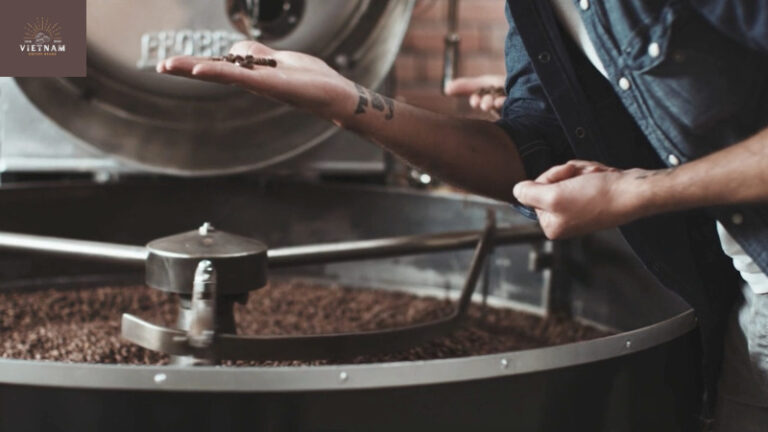As a coffee roaster with over 10 years of experience, I’ve seen my fair share of roasting defects. While no toast is ever perfect, there are some common mistakes that all roasters should avoid.
Understanding the causes and solutions for these Coffee Roasting Defects is key to producing delicious and consistent coffee. Thus, let’s read on with vietnamcoffeebeans to learn the how-to!
Key Takeaways
- Follow an appropriate toast profile with gradual heat increases.
- Closely monitor time and temperature throughout the roast (see time and temperature factors in professional coffee roasting).
- Frequently sample grains to check color and flavor development.
- Listen for the first and second cracks and end the toast at the right time.
- Store grains properly to maintain freshness and prevent staling.
- Source high-quality green grains and remove any defective beans (see where to buy green coffee beans for roasting).
What Are Coffee Roasting Defects?
Understanding coffee bean roasting defects occurs when the green coffee grains are not toasted properly. Defects can happen due to issues with the roasting process, roasting equipment, green bean quality, or home coffee bean roasting techniques. These defects negatively impact the flavor, aroma, acidity, body, and overall quality of the toasted coffee.
Some common roasting defects include:
- Underdeveloped coffee
- Baked coffee
- Scorched coffee
- Tipped coffee
- Overdeveloped coffee
Avoiding defects requires diligence and care throughout the roasting process. Let’s explore some of the most common coffee-toasting defects and how to prevent them.

The 8 Most Common Coffee Toasting Defects
Here are the top coffee roasting mistakes to avoid:
1. Underdeveloped Coffee
Underdeveloped coffee grains have not been sufficiently roasted. They will taste grassy, bitter, and sour, unlike when you discover our Alaska coffee roasting offerings.
This defect happens when the grains are not toasted long enough or at a high enough temperature. The first cracking has not been completed, leaving the grains under-roasted.
How to Avoid It:
- Extend the toast time and raise the temperature to fully develop the beans.
- Ensure the toast profile brings the grains through the first crack.
- Check bean color and flavor development to confirm toast completion.
2. Baked Coffee
Baked coffee grains are over-roasted without reaching the second crack. They will taste dull, flat, and lack sweetness.
This occurs when the grains sit at too low of a temperature for too long during the roast. They are baked rather than properly roasted.
How to Avoid It:
- Speed up the toast time and use a higher temperature rather than baking the beans.
- Adjust the temperature profile to avoid a long, low-temperature period.
- Listen for the first cracking and make sure it completes before lowering the temperature.
3. Scorched Coffee
Scorched coffee grains are burnt and taste extremely bitter, acidic, and sharp. The oils have scorched onto the bean’s surface.
This defect happens when the grains are toasted at too high of a temperature, especially near the end of the roast. The scorching heat damages the beans.
How to Avoid It:
- Closely monitor the temperature profile and avoid excessive high heat.
- Lower the temperature steadily as the toast progresses.
- Listen for the second cracking and end the toast before scorching occurs.

4. Tipped Coffee
Tipped grains have a white, jagged break on the rounded end, making the bean tip appear flattened or broken off.
This happens when the grains suddenly warm up too quickly. The rapid expansion cracks the bean tip open.
How to Avoid It:
- Keep the warmness increased gradually during the toast to avoid shocking the beans.
- Ensure proper bean rotation inside the roaster so no grains get overheated.
- Adjust the hot spots inside the roasting drum to prevent tipping.
5. Overdeveloped Coffee
Overdeveloped coffee is toasted past the second cracking. The grains will taste charred, carbonized, and overly dark.
This occurs when the toast continues too long past the second crack. The extended high warmness over-roasts the beans.
How to Avoid It:
- Listen closely for the second cracking and end the toast soon after.
- Follow an appropriate toast profile and time to avoid over-roasting.
- Visually inspect bean color to identify when to stop the roast.
6. Uneven Roast
Unevenly toasted grains will have a mix of light and dark grains in the batch. Light grains will be under-roasted while dark grains are overdone.
This happens when warmness is unevenly distributed in the roaster, preventing consistent roasting. Beans may clump or get stuck to the roasting drum.
How to Avoid It:
- Frequently stir and rotate the grains for even exposure to heat.
- Check for hot spots in the roaster and adjust the drum speed.
- Ensure the roasting batch size is appropriate for the drum size.
7. Stale Roasted Coffee
BeansRoasted coffee goes stale quickly after roasting. The coffee will taste flat and flavorless.
Staling happens due to improper storage and the release of carbon dioxide post-roast. Oxygen and light exposure accelerate staling.
How to Avoid It:
- Use a valve bag to allow gases to escape while keeping oxygen out.
- Store grains in an airtight container in a cool, dark place.
- Grind grains right before brewing to maximize freshness.
- Label roasting dates and rotate stock to use the freshest grains first.
8. Poor Green Bean Quality
Low-quality green grains lead to unpleasant flavors like earthiness, moldiness, fermentation, and more.
This occurs when poor harvest, processing, drying, sorting, and storage practices impact the green beans. Defective grains slip through quality control.
How to Avoid It:
- Source high-quality green grains from reputable specialty coffee growers and importers.
- Inspect grains upon arrival and remove any defective beans.
- Control temperature and humidity during storage and transportation.
- Establish trusted relationships with growers who use best practices.
While some defects are inevitable, paying close attention and making adjustments during roasting can significantly reduce quality issues. Mastering the toast is a lifelong process, but avoiding these common mistakes is a huge step forward.

Frequently Asked Questions
Conclusion
Avoiding common coffee roasting mistakes takes attentiveness and experience. But being aware of these potential defects, their causes, and solutions will help any roaster produce dramatically better coffee. Pay close attention to time, temperature, bean development, and storage.
With care and finesse, you can master the toast and bring out the absolute best flavors from those magical green beans.





